Peugeot Boxer 2008.5 Manual PDF
Manufacturer: PEUGEOT, Model Year: 2008.5, Model line: Boxer, Model: Peugeot Boxer 2008.5Pages: 167, PDF Size: 4.17 MB
Page 71 of 167
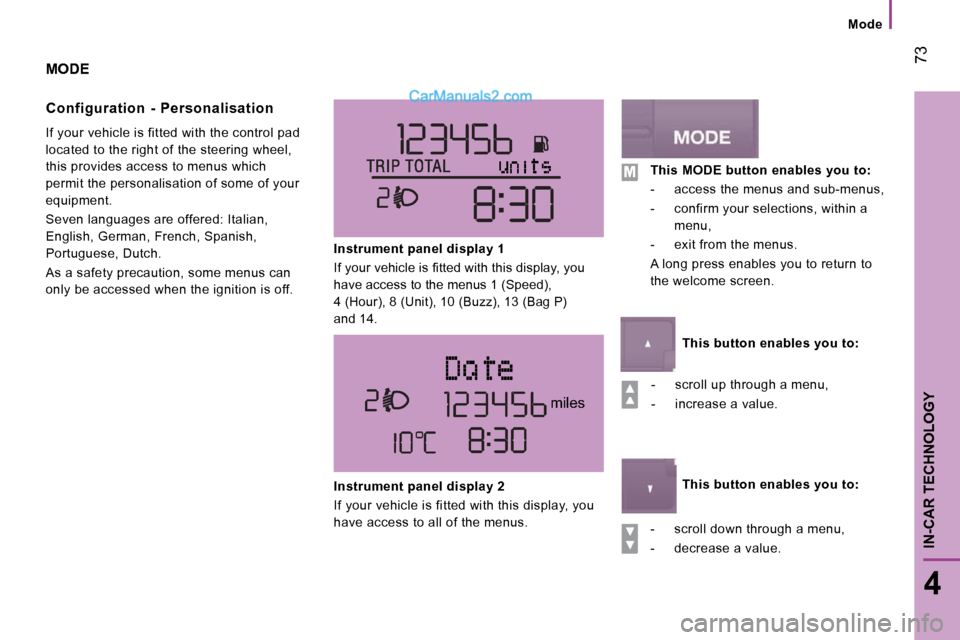
miles
73
4
IN-CAR TECHNOLOGY
Mode
MODE
Configuration - Personalisation
If your vehicle is fitted with the control pad
located to the right of the steering wheel,
this provides access to menus which
permit the personalisation of some of your
equipment.
Seven languages are offered: Italian,
English, German, French, Spanish,
Portuguese, Dutch.
As a safety precaution, some menus can
only be accessed when the ignition is off. Instrument panel display 1
� �I�f� �y�o�u�r� �v�e�h�i�c�l�e� �i�s� �fi� �t�t�e�d� �w�i�t�h� �t�h�i�s� �d�i�s�p�l�a�y�,� �y�o�u�
have access to the menus 1 (Speed),
4 (Hour), 8 (Unit), 10 (Buzz), 13 (Bag P)
and 14.
- scroll up through a menu,
- increase a value.
- scroll down through a menu,
- decrease a value.
Instrument panel display 2
If your vehicle is fitted with this display, you
have access to all of the menus.
This MODE button enables you to:
- access the menus and sub-menus,
- confirm your selections, within a menu,
- exit from the menus.
A long press enables you to return to
the welcome screen.
This button enables you to:
This button enables you to:
Page 72 of 167
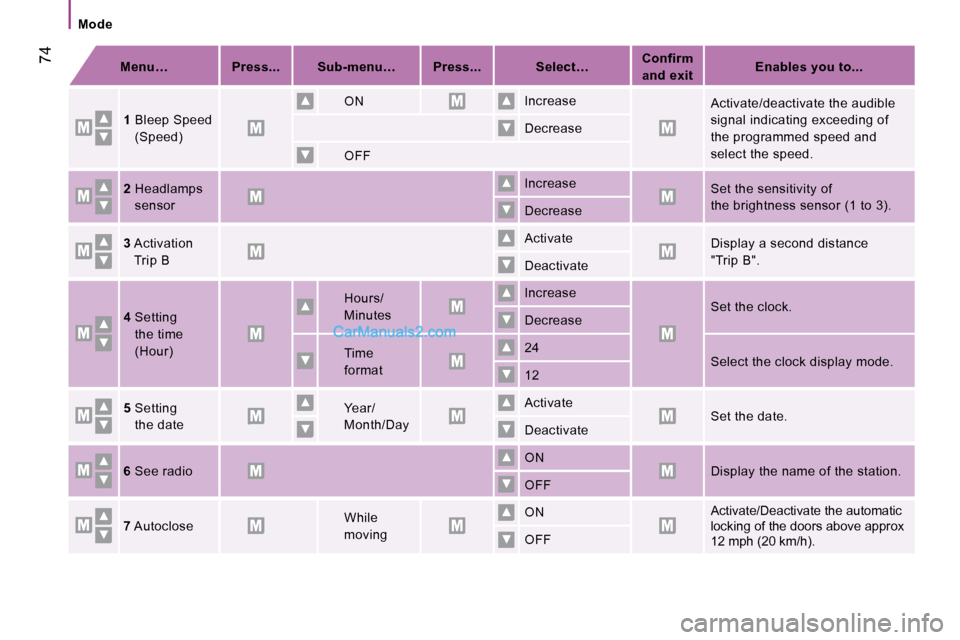
74
Mode
Menu… Press... Sub-menu… Press... Select…
Confirm
and exit
Enables you to...
1 Bleep Speed
(Speed)
ON
Increase
Activate/deactivate the audible
signal indicating exceeding of
the programmed speed and
select the speed.
Decrease
OFF
2 Headlamps
sensor Increase Set the sensitivity of
the brightness sensor (1 to 3).
Decrease
3 Activation
Trip B
Activate Display a second distance
"Trip B".
Deactivate
4 Setting
the time
(Hour)
Hours/
Minutes
Increase
Set the clock.
Decrease
Time
format 24
Select the clock display mode.
12
5 Setting
the date
Year/
Month/Day Activate Set the date.
Deactivate
6 See radio
ON Display the name of the station.
OFF
7 Autoclose
While
moving ON Activate/Deactivate the automatic
locking of the doors above approx
12 mph (20 km/h).
OFF
Page 73 of 167
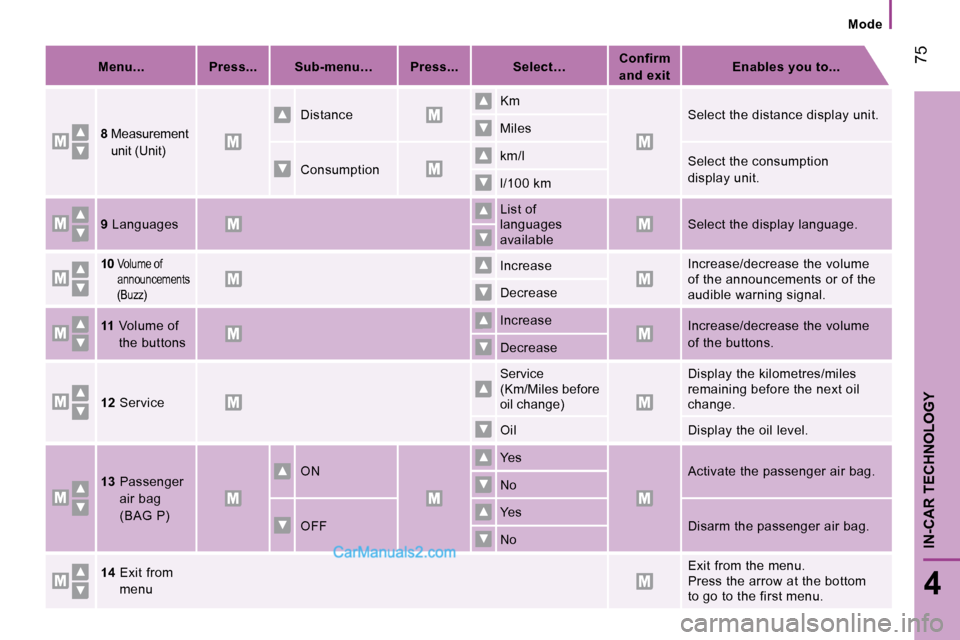
75
4
IN-CAR TECHNOLOGY
Mode
Menu... Press... Sub-menu… Press... Select…
Confirm
and exit
Enables you to...
8 Measurement
unit (Unit)
Distance
Km
Select the distance display unit.
Miles
Consumption km/l
Select the consumption
display unit.
l/100 km
9 Languages
List of
languages
available Select the display language.
10
Volume of
announcements
(Buzz) Increase Increase/decrease the volume
of the announcements or of the
audible warning signal.
Decrease
11 Volume of
the buttons
Increase Increase/decrease the volume
of the buttons.
Decrease
12 Service
Service
(Km/Miles before
oil change)
Display the kilometres/miles
remaining before the next oil
change.
Oil Display the oil level.
13 Passenger
air bag
(BAG P)
ON
Yes
Activate the passenger air bag.
No
OFF Yes
Disarm the passenger air bag.
No
14 Exit from
menu
Exit from the menu.
Press the arrow at the bottom
to go to the first menu.
Page 74 of 167
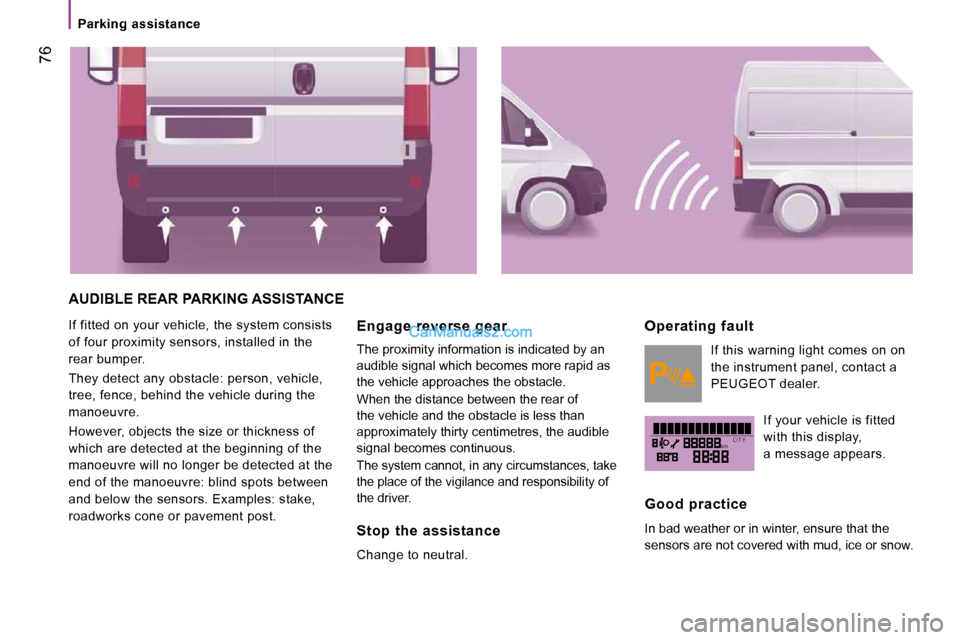
kmC I T Y
76
Parking assistance
AUDIBLE REAR PARKING ASSISTANCE
If fitted on your vehicle, the system consists
of four proximity sensors, installed in the
rear bumper.
They detect any obstacle: person, vehicle,
tree, fence, behind the vehicle during the
manoeuvre.
However, objects the size or thickness of
which are detected at the beginning of the
manoeuvre will no longer be detected at the
end of the manoeuvre: blind spots between
and below the sensors. Examples: stake,
roadworks cone or pavement post. Engage reverse gear
The proximity information is indicated by an
audible signal which becomes more rapid as
the vehicle approaches the obstacle.
When the distance between the rear of
the vehicle and the obstacle is less than
approximately thirty centimetres, the audible
signal becomes continuous.
The system cannot, in any circumstances, take
the place of the vigilance and responsibility of
the driver.
Stop the assistance
Change to neutral.
Operating fault
If this warning light comes on on
the instrument panel, contact a
PEUGEOT dealer. If your vehicle is fitted
with this display,
a message appears.
Good practice
In bad weather or in winter, ensure that the
sensors are not covered with mud, ice or snow.
Page 75 of 167
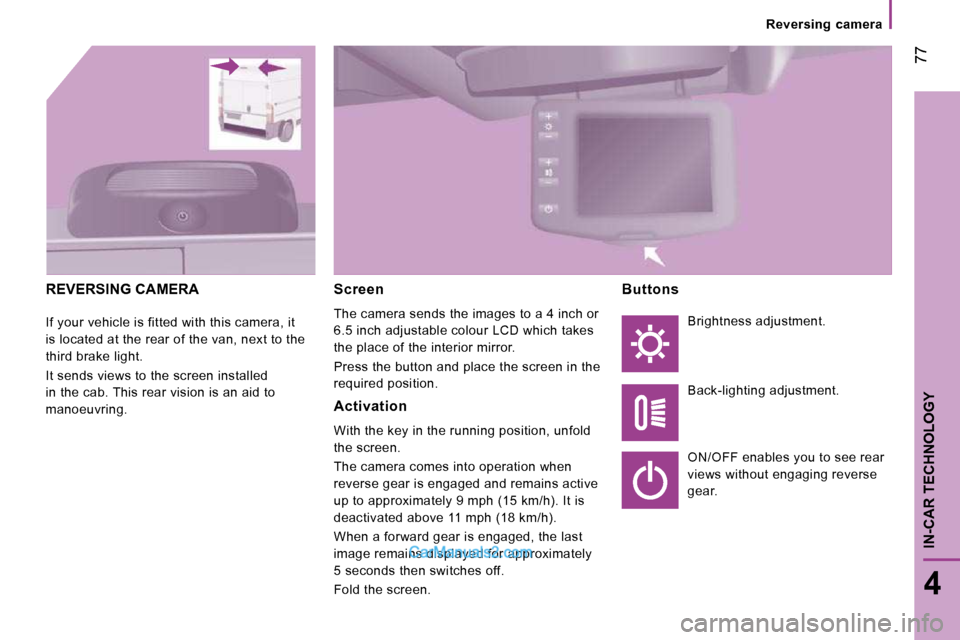
77
4
IN-CAR TECHNOLOGY
Reversing camera
REVERSING CAMERA
If your vehicle is fitted with this camera, it
is located at the rear of the van, next to the
third brake light.
It sends views to the screen installed
in the cab. This rear vision is an aid to
manoeuvring.
Screen
The camera sends the images to a 4 inch or
6.5 inch adjustable colour LCD which takes
the place of the interior mirror.
Press the button and place the screen in the
required position.
Activation
With the key in the running position, unfold
the screen.
The camera comes into operation when
reverse gear is engaged and remains active
up to approximately 9 mph (15 km/h). It is
deactivated above 11 mph (18 km/h).
When a forward gear is engaged, the last
image remains displayed for approximately
5 seconds then switches off.
Fold the screen.
Buttons
Brightness adjustment.
Back-lighting adjustment.
ON/OFF enables you to see rear
views without engaging reverse
gear.
Page 76 of 167
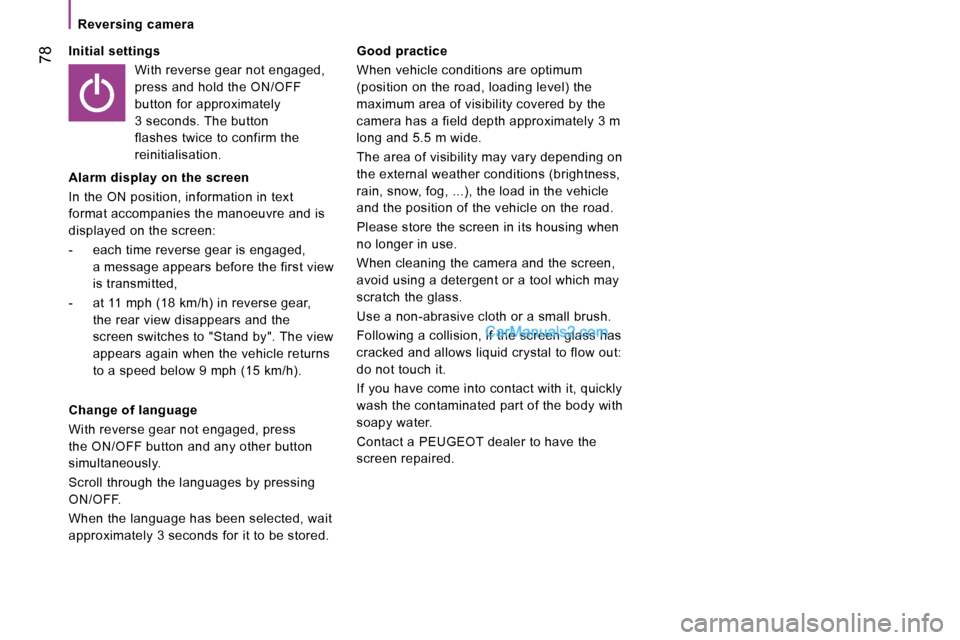
78
Reversing camera
Initial settings With reverse gear not engaged,
press and hold the ON/OFF
button for approximately
3 seconds. The button
flashes twice to confirm the
reinitialisation.
Alarm display on the screen
In the ON position, information in text
format accompanies the manoeuvre and is
displayed on the screen:
- each time reverse gear is engaged, a message appears before the first view
is transmitted,
- at 11 mph (18 km/h) in reverse gear, the rear view disappears and the
screen switches to "Stand by". The view
appears again when the vehicle returns
to a speed below 9 mph (15 km/h).
Change of language
With reverse gear not engaged, press
the ON/OFF button and any other button
simultaneously.
Scroll through the languages by pressing
ON/OFF.
When the language has been selected, wait
approximately 3 seconds for it to be stored. Good practice
When vehicle conditions are optimum
(position on the road, loading level) the
maximum area of visibility covered by the
camera has a field depth approximately 3 m
long and 5.5 m wide.
The area of visibility may vary depending on
the external weather conditions (brightness,
rain, snow, fog, ...), the load in the vehicle
and the position of the vehicle on the road.
Please store the screen in its housing when
no longer in use.
When cleaning the camera and the screen,
avoid using a detergent or a tool which may
scratch the glass.
Use a non-abrasive cloth or a small brush.
Following a collision, if the screen glass has
cracked and allows liquid crystal to flow out:
do not touch it.
If you have come into contact with it, quickly
wash the contaminated part of the body with
soapy water.
Contact a PEUGEOT dealer to have the
screen repaired.
Page 77 of 167
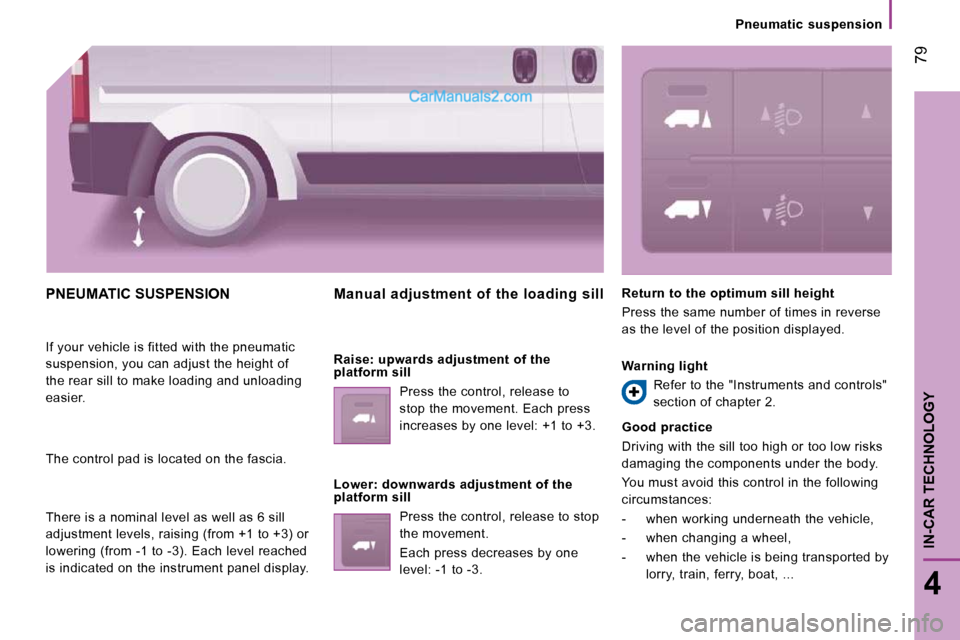
79
4
IN-CAR TECHNOLOGY
Pneumatic suspension
PNEUMATIC SUSPENSION
If your vehicle is fitted with the pneumatic
suspension, you can adjust the height of
the rear sill to make loading and unloading
easier.
The control pad is located on the fascia.
There is a nominal level as well as 6 sill
adjustment levels, raising (from +1 to +3) or
lowering (from -1 to -3). Each level reached
is indicated on the instrument panel display.
Manual adjustment of the loading sill
Raise: upwards adjustment of the
platform sill Press the control, release to
stop the movement. Each press
increases by one level: +1 to +3.
Lower: downwards adjustment of the
platform sill Press the control, release to stop
the movement.
Each press decreases by one
level: -1 to -3. Return to the optimum sill height
Press the same number of times in reverse
as the level of the position displayed.
Warning light
Refer to the "Instruments and controls"
section of chapter 2.
Good practice
Driving with the sill too high or too low risks
damaging the components under the body.
You must avoid this control in the following
circumstances:
- when working underneath the vehicle,
- when changing a wheel,
- when the vehicle is being transported by lorry, train, ferry, boat, ...
Page 78 of 167
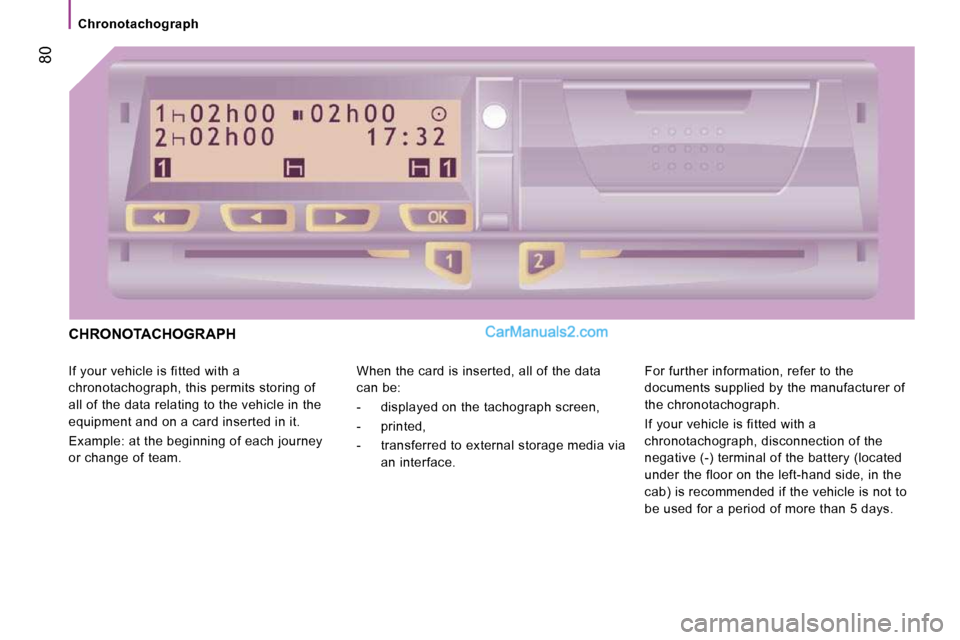
80
Chronotachograph
CHRONOTACHOGRAPH
If your vehicle is fitted with a
chronotachograph, this permits storing of
all of the data relating to the vehicle in the
equipment and on a card inserted in it.
Example: at the beginning of each journey
or change of team. When the card is inserted, all of the data
can be:
- displayed on the tachograph screen,
- printed,
- transferred to external storage media via
an interface. For further information, refer to the
documents supplied by the manufacturer of
the chronotachograph.
If your vehicle is fitted with a
chronotachograph, disconnection of the
negative (-) terminal of the battery (located
under the floor on the left-hand side, in the
cab) is recommended if the vehicle is not to
be used for a period of more than 5 days.
Page 79 of 167
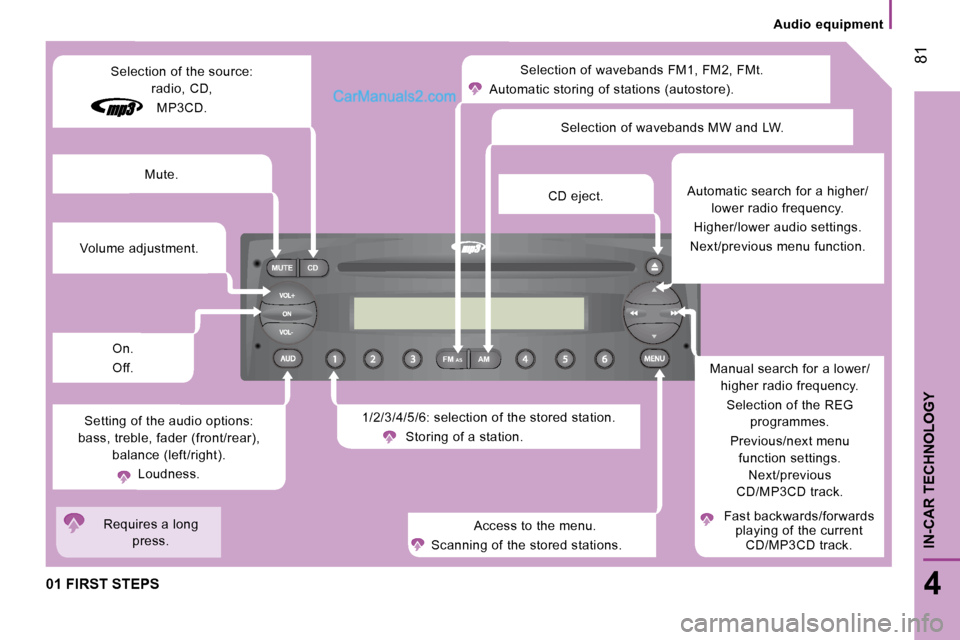
FM
MUTE CD
AM
AS
81
4
IN-CAR TECHNOLOGY
Audio equipment
01 FIRST STEPS
Selection of wavebands FM1, FM2, FMt.
Automatic storing of stations (autostore).
1/2/3/4/5/6: selection of the stored station. Storing of a station.
Access to the menu.
Scanning of the stored stations. Manual search for a lower/
higher radio frequency.
Selection of the REG programmes.
Previous/next menu function settings. Next/previous
CD/MP3CD track.
Fast backwards/forwards playing of the current CD/MP3CD track.
Automatic search for a higher/
lower radio frequency.
Higher/lower audio settings.
Next/previous menu function.
CD eject. Selection of wavebands MW and LW.
Setting of the audio options:
bass, treble, fader (front/rear), balance (left/right).
Loudness.
Volume adjustment.
On.
Off.
Selection of the source:
radio, CD,
MP3CD.
Mute.
Requires a long press.
Page 80 of 167
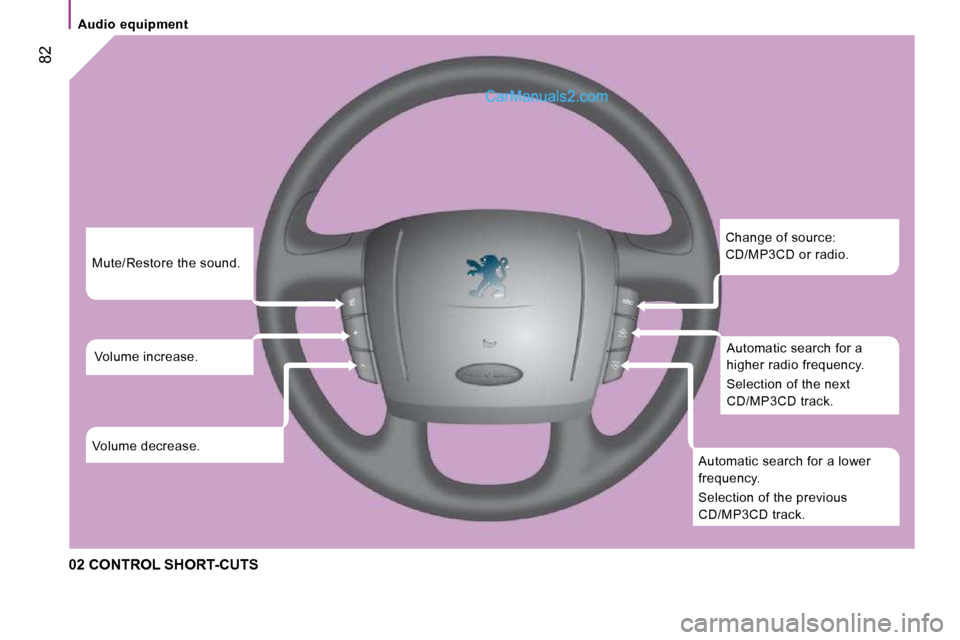
82
Audio equipment
02 CONTROL SHORT-CUTS
Change of source:
CD/MP3CD or radio. Automatic search for a
higher radio frequency.
Selection of the next
CD/MP3CD track.
Automatic search for a lower
frequency.
Selection of the previous
CD/MP3CD track.
Mute/Restore the sound.
Volume increase.
Volume decrease.